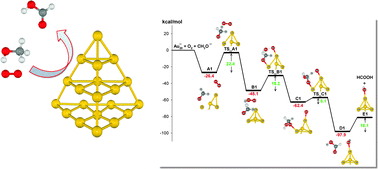Aerobic oxidation of methanol to formic acid on Au20−: a theoretical study on the reaction mechanism†
Abstract
The aerobic

* Corresponding authors
a
Research Center for Computational Science, 38 Nishigonaka, Myodaiji, Okazaki 444-8585, Japan
E-mail:
ehara@ims.ac.jp
b
Institute for Molecular Science, 38 Nishigonaka, Myodaiji, Okazaki 444-8585, Japan
E-mail:
hsakurai@ims.ac.jp
The aerobic

 Please wait while we load your content...
Something went wrong. Try again?
Please wait while we load your content...
Something went wrong. Try again?
K. Bobuatong, S. Karanjit, R. Fukuda, M. Ehara and H. Sakurai, Phys. Chem. Chem. Phys., 2012, 14, 3103 DOI: 10.1039/C2CP23446G
To request permission to reproduce material from this article, please go to the Copyright Clearance Center request page.
If you are an author contributing to an RSC publication, you do not need to request permission provided correct acknowledgement is given.
If you are the author of this article, you do not need to request permission to reproduce figures and diagrams provided correct acknowledgement is given. If you want to reproduce the whole article in a third-party publication (excluding your thesis/dissertation for which permission is not required) please go to the Copyright Clearance Center request page.
Read more about how to correctly acknowledge RSC content.
 Fetching data from CrossRef.
Fetching data from CrossRef.
This may take some time to load.
Loading related content
